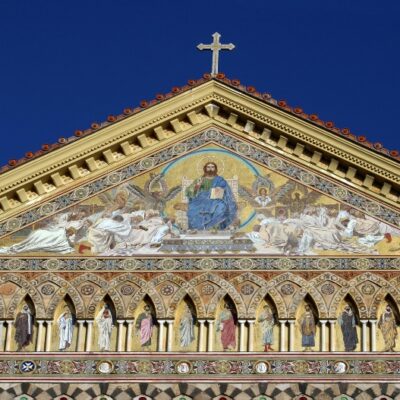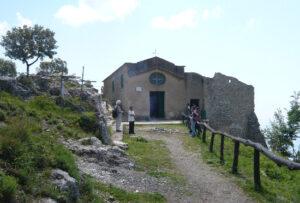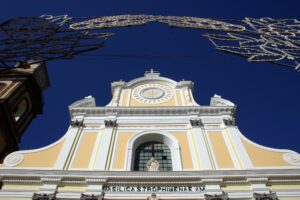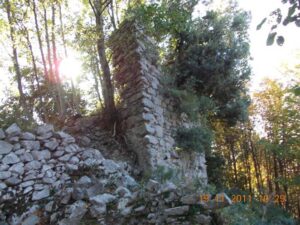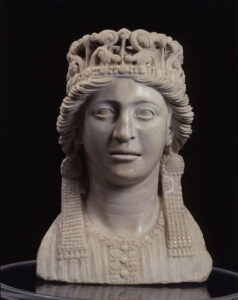MUNICIPALITY: Amalfi
NAME: Cattedrale S. Andrea Apostolo / Cathedral of St. Andrew the Apostle
LOCATION: Piazza Duomo
DESCRIPTION: The cathedral dedicated to St. Andrew whose body was brought to Amalfi from Constantinople only in 1208 and is preserved in the crypt below, dates back to 987, although it has been renovated several times over the centuries.
the original core can be guessed by looking at the decorative structures still visible on the right wall of the transept (interlaced arches).
The plan of the cathedral with three naves, divided by arches standing on pillars (originally columns) covered with marble, presents the Baroque appearance desired by Bishop M. Bologna. .
In the central apse, the high altar of 1711 by Giuseppe and Paolo Mozzetti contains, framed by a Baroque broken tympanum structure, a painting of the Martyrdom of the Saint by Dell’Asta.
The apse basin, lunetted (lunettato*) by Baroque ribs, shows three frescoes (St. Andrew, the Assumption of the Virgin Mary, St. John the Baptist), also by Dell’Asta, painted in 1715. The side apses deepen to contain on the right the Chapel of the Coro dei Canonici dated 1700, on the left the Chapel of the Sacrament, also dated 1700, with a frescoed ribbed vault.
The aisles show five chapels on each side; on the right, beginning at the entrance, is the chapel containing three statues (St. John the Evangelist, St. John the Baptist, St. Benedict); the others contain canvases from the 1700s, works by Silvestro Mirra and his school (the Virgin, St. Michael, St. Nicholas, and the Nativity); to the left, after the red porphyry baptismal font, the chapels contain canvases also by Mirra (St. Eustace, the Virgin, St. Gaetano da Tiene with St. Andrea Avellino, the Virgin).
The counterfaçade of the right aisle shows Ottavio Elioni’s painting (18th century) of the miracle of the patron saint.
The ceiling is flat with golden coffers and contains canvases by Dell’Asta with scenes from the life of the saint; in the transept the canvases are by Giuseppe Castellano (18th century – Vocation of the Saint and Miraculous Fishing).
Open glass cases on the side walls enshrine a silver reliquary of St. Andrew (16th century) and a mother-of-pearl cross by Msgr. Marini (1930).
Other interesting works include the Eucharistic table, consisting of the sarcophagus of Bishop Pietro Capuano (1360); the two monolithic red marble columns set to frame the presbytery; and the two candlesticks, with the columns supporting them, with mosaic decoration. The right aisle leads to the octagonal sacristy, built in 1786 with interesting frescoes.
The entrance to the cathedral consists of an atrium, commissioned by Cardinal Pietro Capuano, in the 13th century, frescoed in 1929 by Paolo Vetri, with scenes from the life of Christ and St. Andrew; above it there’s the central door, made of bronze, built in Constantinople in 1060, formed of tiles with cruciform motifs.
The façade, gabled, with interlaced arches, shows the 19th-century architectural phase (there was a collapse in 1861, so it was rebuilt by Alvino and Raimondi), with mosaics designed by Domenico Morelli.
The crypt, which can be accessed by a staircase in the right aisle, was built in 1203 to house the body of St. Andrew. It is divided longitudinally into two naves by pillars, covered with marble, supporting cross vaults entirely frescoed in the 1600s by Neapolitan artists, including Aniello Falcone. The altar, dating from 1500, shows a bronze statue of St. Andrew by Michelangelo Naccherini and marble statues of St. Stephen and St. Lawrence, works by Pietro Bernini.
The bell tower, which construction started in 1180, shows a gradual lightening of the structures achieved through wider openings and with the circular belfry, surrounded by four smaller cells and decorated with two-colored motifs of interlaced arches and the green and yellow majolica tiles of the dome.
SEE, VISIT, FIND: The Cathedral can be accessed, with free entrance, during liturgical services, while visiting is always possible, entering through the Paradise Cloister, with a ticket that includes a visit to the cloister and the Basilica of the Crucifix.
FRUITION DATA: The Cathedral is the arrival point for all visitors to Amalfi.
BIBLIOGRAFY (a c.) GARGANO O., Amalfi la città famosa, la città da scoprire, Amalfi 1995.
FIENGO G, Errico Alvino e la ricostruzione dell’Atrio e della facciata del Duomo di Amalfi, Roma 1992.
FIENGO G., Il Duomo di Amalfi. Restauro ottocentesco della facciata, in RCCSA 1991.
SCHIAVO A., Monumenti della Costa di Amalfi, Milano 1941.

